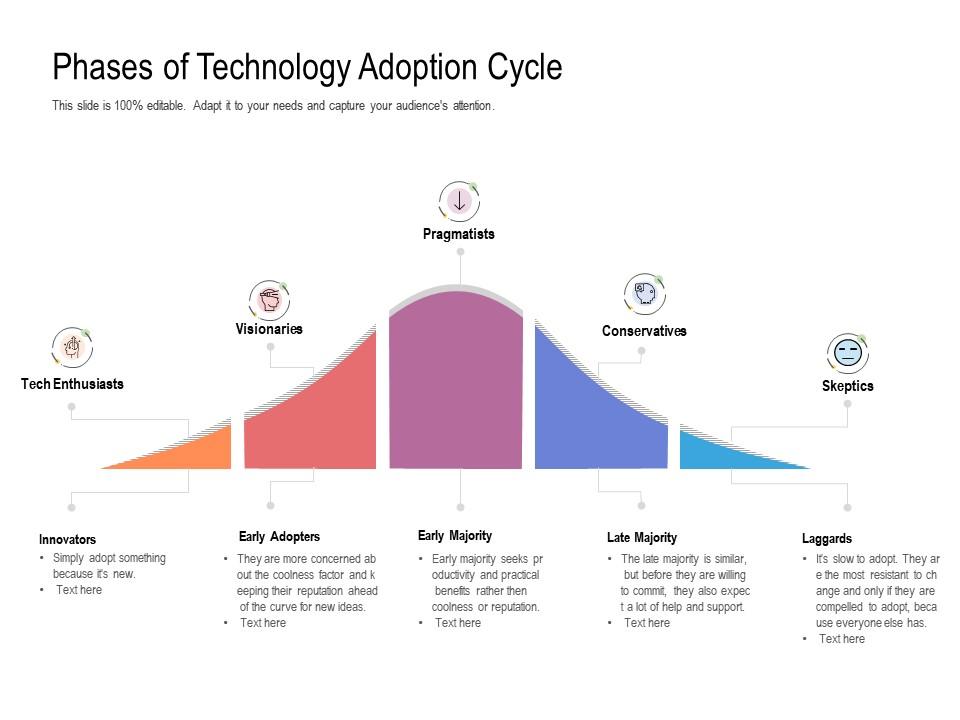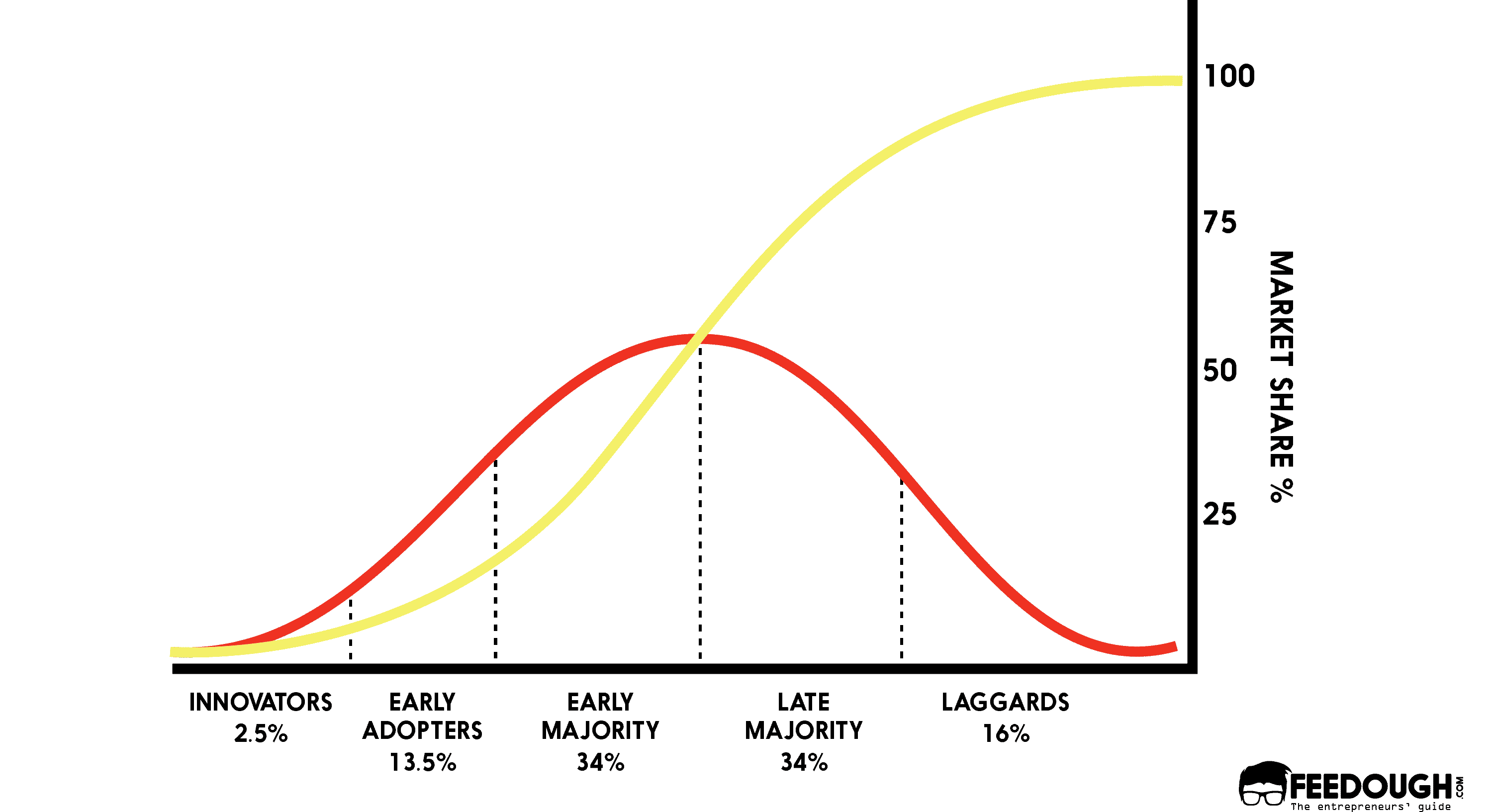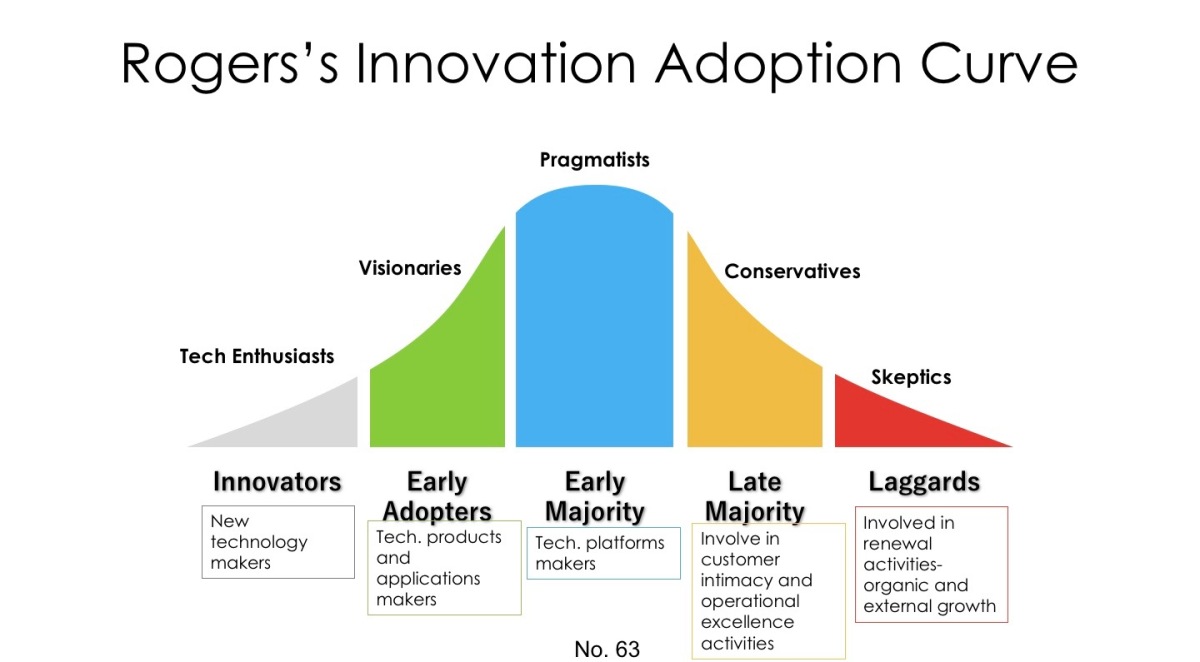
Innovation Adoption Lifecycle Download Scientific Diagram
The Technology Adoption Lifecycle (or the Technology Adoption Curve) is a sociological model that describes the adoption or acceptance of a new innovation by certain defined adopter groups - Innovators, early adopters, early majority, late majority, and laggards.

Crossing the Chasm in Technology Adoption Life Cycle EXPLAINED B2U
The technology adoption lifecycle is a sociological model that describes the adoption or acceptance of a new product or innovation, according to the demographic and psychological characteristics of defined adopter groups. The process of adoption over time is typically illustrated as a classical normal distribution or "bell curve".

Innovation adoption lifecycle and market development stages Download Scientific Diagram
The innovation-adoption curve describes the sequence of adopter types Reinvention is the primary concept in Diffusion of Innovations. The success of an innovation depends on how well it evolves to meet the needs of more and more demanding and risk-averse individuals in a population.

5 Focus areas for startup innovation Startup CTO for Growth
Originated from a study on farmers behaviour, innovation adoption lifecycle states how an idea diffuses/spreads from the earliest adopters (innovators) to the laggards. It is a sociological model that describes the adoption of innovation according to the demographic and psychological characteristics of the target audience.

Life Cycle Of Technology Adoption PowerPoint Slides Diagrams Themes for PPT Presentations
The innovation life cycle moderates resource-adoption decision relationships in organizations. Organizational resource-adoption decision associations are stronger for early adopters than for late adopters. 2.4 Control variables. Whether the results are affected by various research designs is controlled for, for robustness testing.

Phases Of Technology Adoption Cycle PowerPoint Slides Diagrams Themes for PPT
The innovation adoption lifecycle is a concept that describes the composition of the buyer base in the life cycle of an innovation. It provides insights into how different groups of customers adopt an innovation over time. This understanding is crucial for businesses to identify their target audience and tailor their marketing efforts accordingly.

Bell Curve Innovation Adoption Lifecycle Download Scientific Diagram
Measures to tackle rising costs include improving labor productivity and the application of technological innovation across both administration and care delivery workflows (for example, further process standardization and outsourcing, increased use of digital care, and early adoption of AI within administrative workflows such as revenue cycle management).

Adopting innovation contract automation product lifecycle explained Weagree
What is the technology adoption lifecycle? The technology adoption lifecycle is a description of customer behavior related to the acceptance of a new product or feature, which is often broken into innovators, early adopters, early majority, late majority and laggards.

Innovation adoption lifecycle and market development stages Download Scientific Diagram
The Innovation Lifecycle: A Definition The term innovation is widely known, even though it is often confused with Inventions. We have already explained the difference between the two terms in more detail in our post Innovation vs. Invention. So, we will focus on the innovation cycle.

Visualization of the innovationadoption lifecycle (adapted from Rogers... Download Scientific
1. Innovators (2.5%) Innovators are those who are willing to take risks. Innovators are those in the technology adoption life cycle who love trying new things and may even be the people encouraging others to try out a new app or tool. Adopters from this part of the technology adoption curve like going against the grain and trying new things.

Technology Adoption Life Cycle Technology Wealth
How and why individuals adopt innovations has motivated a great deal of research. This article examines individuals' computing adoption processes through the lenses of three adoption theories: Rogers's innovation diffusion theory, the Concerns-Based Adoption Model, the Technology Acceptance Model, and the United Theory of Acceptance and Use of Technology.

Understanding The Innovation Adoption Lifecycle Feedough
The life cycle represents how different people, based on age, income, and other demographic and psychological characteristics, begin adopting a new piece of technology. In time, such new technology reaches its potential, diffusing among all society members until it becomes second nature.

Understanding The Innovation Adoption Lifecycle Feedough
Everett Rogers identified five personas for innovation adoption: Innovators, Early Adopters, Early Majority, Late Majority, and Laggards.

Innovation Adoption Lifecycle The W Guide
April 24, 2022 Crossing the Innovation Adoption Gap with Life Cycle Assessment Innovation reshapes our world, leading to groundbreaking products and services that revolutionize industries and improve lives.

What is the adoption curve of innovation, and how does it work? DLIT
Crossing the Chasm is an adaptation of an innovation-adoption model called diffusion of innovations theory created by Everett Rogers, The author argues there is a chasm between the early adopters of the product (the technology enthusiasts and visionaries) and the early majority (the pragmatists). Moore believes visionaries and pragmatists have very different expectations, and he attempts to.

What Is A Technology Adoption Curve? The Five Stages Of A Technology Adoption Life Cycle
The review identified 20 theoretical frameworks that could be grouped into two broad categories: theories that mainly address the adoption process ( N = 10) and theories that address adoption within the context of implementation, diffusion, dissemination, and/or sustainability ( N = 10).